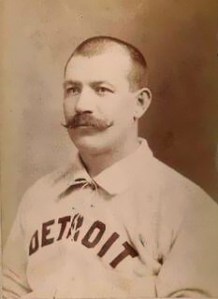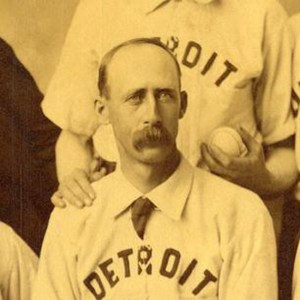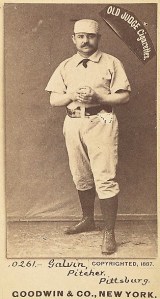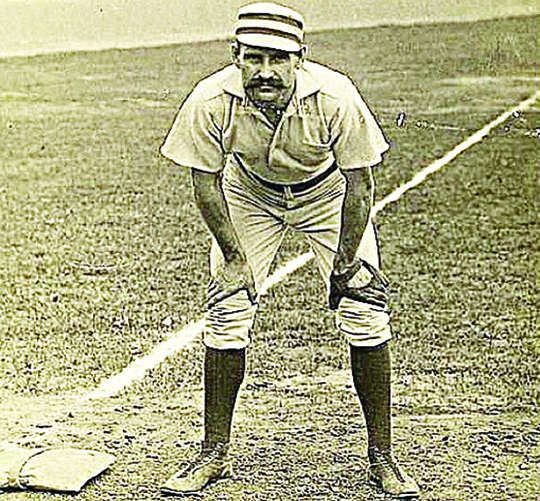When we last left the 1883 New York Gothams, they were finally playing good baseball, but found themselves still mired in sixth place with a 10-13 record.


On June 8, 1883, the Gothams began a four-game series at home in the Polo Grounds against the Buffalo Bisons.
The Bisons were a strong club, who also boasted four future Baseball Hall of Fame players: first baseman Dan Brouthers, third baseman Deacon White, catcher and outfielder Jim O’Rourke, and right-handed pitcher James Galvin.
“Big Dan” Brouthers was a giant in his time, standing 6’ 2” and weighing in at 207 pounds. He was the prototype of the slugging first baseman: a dominant hitter who led the National League in offensive WAR an astonishing eight times, while capturing five batting titles. Brouthers’ lifetime .342 batting average is the ninth best in the history of baseball.

Deacon White was one of the great all-around players in baseball in the 19th century. In his 20-year career from 1871 to 1890, White starred for seven pennant winning clubs and earned a reputation as baseball’s most honest player.
In 1875 he received baseball’s first most valuable player award when he hit .367 as a catcher and led the Boston Red Stockings (now the Atlanta Braves) to a staggering 71-8 record.
Deacon White was finally inducted to the Hall of Fame in 2013, a mere 74 years after his death. He is arguably the least imposing, meekest looking superstar in baseball history.
“Orator Jim” O’Rourke was another of baseball’s first stars, nicknamed for his “proclivity for grandiloquence.”

On April 22, 1876, he slugged the very first hit in National League history. Oddly O’Rourke was joined in the Buffalo Bisons’ outfield by another orator, George “Orator” Shafer, who reportedly received his moniker because he never stopped talking, even to himself.
But arguably the Bisons’ franchise player was James “Pud” Galvin, who was the Bisons’ ace during Buffalo’s National League tenure, from 1879 to 1885. At 5’ 8”, and 200 plus pounds, Galvin was known as “The Little Steam Engine” for his relentless durability, and as “Pud”, reputedly for his ability to turn batters into pudding.
The portly righthander would eventually become baseball’s first 300 game winner. In 1883 he was in the midst of chalking up impressive back-to-back 46-win seasons. In 1884, the year “Old Hoss” Radbourne won an unfathomable 59 games, it was actually Galvin, who led the league in pitching WAR with an all-time record 20-5.

Pud Galvin was also baseball’s first known user of performance enhancing drugs.
In 1889, it was reported that Galvin was involved in a medical trial involving Brown-Séquard elixir, a dubious concoction of testosterone culled from dog and guinea pig testicles.
Shortly after starting to drink Brown-Séquard, he pitched a 2-0 shutout, and his success was credited to the pseudo-magic restorative. This apparently was a one-time only trial and the elixir was later determined to have zero medical value. But this shady episode was enough for some people to call “Pud” an early pioneer in the use of PED’s.
Now back to the Gotham’s battles with the Buffalo Bisons.
James Galvin demonstrated his freakish durability to the Gothams by leading the Bisons to two straight wins to open the series on June 8 and 9, 1883. The Gothams reversed their fortunes with an 11-7 victory over Galvin in game three on June 11th.
New York’s offensive onslaught continued with a 17-8 demolition over Buffalo’s change pitcher, George Derby. In the 1880’s a “change pitcher” described a ballclub’s number two pitcher, since most teams used only one pitcher to start almost all of their games.
George Derby was just two years removed from one of the great rookie seasons of all-time. In 1881, the 23-year-old Derby won 29 games for the Detroit Wolverines, with 9 shutouts. He also had a league leading 212 strikeouts in 494.1 innings.
But those halcyon days were long gone, as the now 25-year-old Derby was in the midst of his final weeks in the major leagues. When he made his final major league appearance on July 3, 1883, his record was a dismal 2-10 with a 5.85 ERA.
The familiar tale of the young phenom pitcher flaming out due to arm problems is as old as baseball itself.
After splitting the Bisons series, 2-2, the Gothams were slated to play the Cleveland Blues in a three-game series to close out the Gothams’ current home stand.
“Smiling” Mickey Welch took the first decision with a 5-0 shutout over Bisons nemesis Hugh “One Arm” Daily on June 14 in front of 1,500 fans at the Polo Grounds. Cleveland took the second game with a 6-3 victory over Johnny Ward the following day.
The Gothams finished the home stand with a June 16th game. It was Ladies’ Day at the Polo Grounds and the stands were packed with 5,000 enthusiastic fans. The Ladies’ Day phenomenon at ballparks was originated around this time, where the fairer sex gained free admittance to the ballpark in hopes of classing up the atmosphere. It was reported that 500 ladies occupied the grandstand.
The Gothams’ erratic righthander “Tip” O’Neill out-dueled the hard-throwing “One Arm” Daily to the delight of the ladies and men alike, taking a 5-2 victory over the Cleveland Blues. And with that, the Gothams took a series victory to close out their home stand.
At 14-16, the Gothams were still stuck in sixth place, but just 7.0 games out of first place.
Credit to Charles Hausberg and his biography of “Pud” Galvin for the Society of American Baseball Research’s biography project.
Add The Sports Daily to your Google News Feed!
